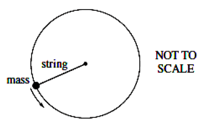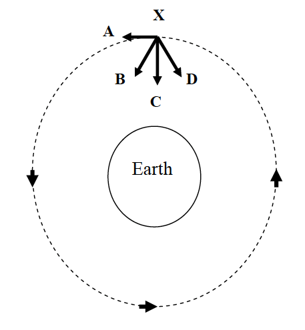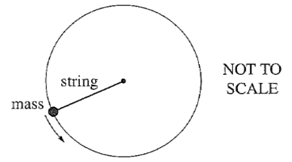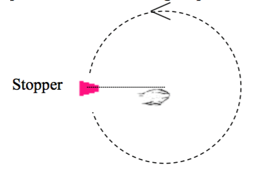Physics – Sample Multiple Choice Quiz
Physics – Sample Multiple Choice Quiz
Quiz Summary
0 of 7 Questions completed
Questions:
Information
You have already completed the quiz before. Hence you can not start it again.
Quiz is loading…
You must sign in or sign up to start the quiz.
You must first complete the following:
Results
Results
0 of 7 Questions answered correctly
Your time:
Time has elapsed
You have reached 0 of 0 point(s), (0)
Earned Point(s): 0 of 0, (0)
0 Essay(s) Pending (Possible Point(s): 0)
| Average score |
|
| Your score |
|
Categories
- Not categorized 0%
| Pos. | Name | Entered on | Points | Result |
|---|---|---|---|---|
| Table is loading | ||||
| No data available | ||||
- 1
- 2
- 3
- 4
- 5
- 6
- 7
- Current
- Review
- Answered
- Correct
- Incorrect
-
Question 1 of 7
1. Question
1 point(s)A 50 g mass is swung in a horizontal circle as shown. It completes 10 revolutions in 65.2 seconds. The circle has a 50 cm diameter. Which of the following forces is closest to that required to keep the mass moving in this circle?

-
Question 2 of 7
2. Question
1 point(s)A low-earth orbiting satellite moves anti-clockwise around the Earth as shown below. Considering all forces acting on the satellite, which option correctly shows the direction of the net force acting on this low-earth orbiting satellite at point X?

-
Question 3 of 7
3. Question
1 point(s)Two satellites are in orbit around the Earth at the radii shown. Satellite Y has twice the mass of satellite X. If the orbital velocity of X and Y is V(x) and V(y) respectively. What is value of V(y)/V(x)?

-
Question 4 of 7
4. Question
1 point(s)A 200 g mass is swung in a horizontal circle as shown. It completes 3 revolutions in 5 seconds. The circle has a 2 m radius. Which of the following forces is closest to that required to keep the mass moving in this circle?

-
Question 5 of 7
5. Question
1 point(s)The terminal velocity (vt) of a spherical object in Earth’s atmosphere is proportional to the square root of its radius (r). Which graph correctly shows this relationship?
-
Question 6 of 7
6. Question
1 point(s)In an experiment, a rubber stopper on the end of a string is spun anti-clockwise, as shown below. Which diagram below correctly describes the direction of both the stopper’s velocity (v) and the centripetal force (Fc) acting on it whilst in the position shown?

-
Question 7 of 7
7. Question
1 point(s)A plane flies in a uniform horizontal circle at constant speed and height. Which statement about the forces acting on the plane is correct?
